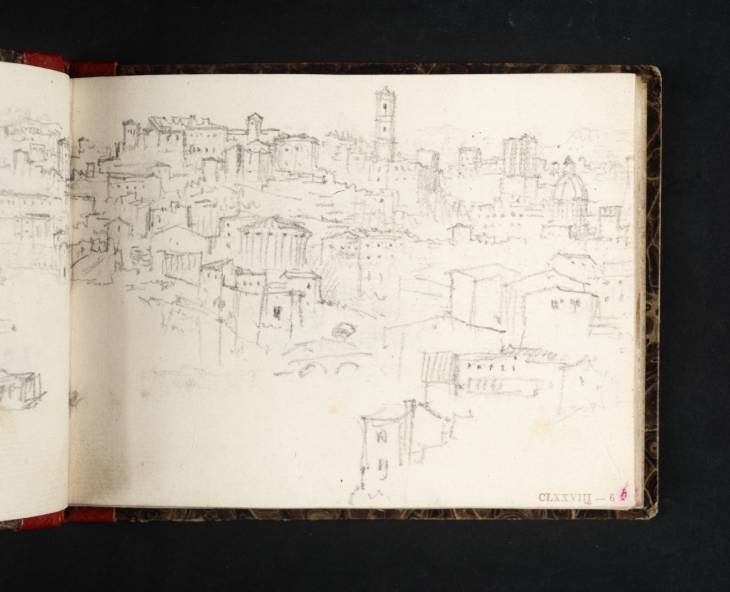Joseph Mallord William Turner Rome, from Mount Aventine 1828-9
Joseph Mallord William Turner,
Rome, from Mount Aventine
1828-9
Folio 6 Recto:
Rome, from Mount Aventine 1828–9
D14842
Turner Bequest CLXXVIII 6
Turner Bequest CLXXVIII 6
Pencil on white laid paper, 97 x 132 mm
Inscribed in red ink ‘6’ bottom right
Stamped in black ‘CLXXVIII – 6’ bottom right
Inscribed in red ink ‘6’ bottom right
Stamped in black ‘CLXXVIII – 6’ bottom right
Accepted by the nation as part of the Turner Bequest 1856
Exhibition history
2007
Colour and Line: Turner’s Experiments [second hang], Tate Britain, London, November 2007–October 2008 (no catalogue).
References
1909
A.J. Finberg, A Complete Inventory of the Drawings of the Turner Bequest, London 1909, vol.I, p.524, CLXXVIII 6, as ‘The Island of the Tiber and Quattro Capi Bridge’.
1975
Gerald Wilkinson, Turner’s Colour Sketches 1820–34, London 1975, p.43, reproduced.
1984
Cecilia Powell, ‘Turner on Classic Ground: His Visits to Central and Southern Italy and Related Paintings and Drawings’, unpublished Ph.D thesis, Courtauld Institute of Art, University of London 1984, pp.224, 337–8, 339, 350, 440, reproduced pl.201 as ‘Sketches of Rome from the Aventine’.
2008
James Hamilton, Nicola Moorby, Christopher Baker and others, Turner e l’Italia, exhibition catalogue, Palazzo dei Diamanti, Ferrara 2008, pp.123, 125 note 24.
2009
James Hamilton, Nicola Moorby, Christopher Baker and others, Turner & Italy, exhibition catalogue, National Galleries of Scotland, Edinburgh 2009, pp.114, 156 note 24.
This panoramic vista of Rome continues onto folio 5 verso opposite (D14841), filling the full double-page spread of the sketchbook. It also extends onto folio 7 recto (D14843); Turner evidently temporarily slid back this page to allow a little more space to complete the vista. His vantage point was from the Aventine Hill, which borders the River Tiber and lies south-west of the Colosseum. Whereas the prospect on the previous double-page spread (folios 4 verso–5 recto; D14839–D14840) offers a north-west perspective from the Aventine Hill, taking in the Trastevere district and the distant Basilica of San Pietro in the Vatican, the viewpoint here shifts further to the north.
In the middle distance, to the left, is the Isola Tiberina. Today, the island is connected to the banks of the Tiber by two bridges: the Cestius Bridge, which leads to Trastevere, and the Fabricius Bridge, shown here towards the foreground. The dome to the right appears to be that of the Church of Santi Luca e Martina Martiri, near the Forum, whereas the distant belltower on the horizon is likely the Torre della Patrina, part of the Palazzo Senatorio on Piazza del Campidoglio, atop the Capitoline Hill. The view extends further eastwards on the opposite page, encompassing more of Trastevere and the partially destroyed Pons Aemilius bridge.
As noted by Cecilia Powell, this work is among five pages in the present sketchbook depicting Rome from Mount Aventine (see also folios 4 verso–5 verso and 7 recto; D14839–D14841, D14843). Turner later drew inspiration from these pencil studies for his oil painting Rome, from Mount Aventine (private collection).1 Commissioned by his friend and patron Hugh Andrew Johnstone Munro of Novar, the painting was exhibited at the Royal Academy, London, in 1836.
Turner also produced a handful of studies of Rome in the Viterbo and Ronciglione sketchbook from the same tour (Tate D21809, D21824–D21826, D21829; Turner Bequest CCXXXVI
23, 32a–33a, 36). Turner’s relatively limited study of Rome in 1828–9 stands in stark contrast to his prolific effort in 1819–20; nine sketchbooks from this period contain views and studies relating to Rome and the surrounding campagna: see Nicola Moorby’s introduction to the ‘First Italian Tour 1819–20’ section of the present catalogue.
23, 32a–33a, 36). Turner’s relatively limited study of Rome in 1828–9 stands in stark contrast to his prolific effort in 1819–20; nine sketchbooks from this period contain views and studies relating to Rome and the surrounding campagna: see Nicola Moorby’s introduction to the ‘First Italian Tour 1819–20’ section of the present catalogue.
Verso:
Blank
Hannah Kaspar
November 2024
How to cite
Hannah Kaspar, ‘Rome, from Mount Aventine 1828–9’, catalogue entry, November 2024, in David Blayney Brown (ed.), J.M.W. Turner: Sketchbooks, Drawings and Watercolours, Tate Research Publication, February 2025, https://www

